
Lime, vanilla, and soothing honey turn Greek yogurt into a special occasion-worthy dessert. This treat is akin to a fruit-topped no-bake cheesecake, but comes together so much faster.
Beauty fruit focus: Lime, kiwi, mango, blueberry, and cherry
Power fruits
Explore a wide range of beautifying fruits to top your dessert including vitamin C-packed kiwis and mangos, crunchy pomegranate seeds, ripe blueberries, and fibre-rich raspberries. Anything tender with a hint of acidity will work well with the creamy whipped yogurt.
Whipped Yogurt with Lime and Fruit
Ingredients
- 1 cup (250 mL) plain Greek yogurt (at least 2% milk fat, without thickeners or gums), cold
- 3/4 cup (180 mL) heavy whipping cream (at least 35% milk fat) or chilled coconut cream, cold
- 3 Tbsp (45 mL) honey or maple syrup, plus more for serving
- 1/2 tsp (2 mL) lime zest, plus more for serving
- 2 tsp (10 mL) lime juice
- 1/2 tsp (2 mL) vanilla bean paste or vanilla extract
- Pinch of salt
- 2 cups (500 mL) fresh fruit such as diced kiwi and mango, blueberries, and cherries, cold
Nutrition
Per serving:
- calories319
- protein28 g
- total fat11 g
- sat. fat8 g
- total carbohydrates28 g
- sugars27 g
- fibre1 g
- sodium117 mg
Directions
01
To stand mixer fitted with whisk attachment, add yogurt, cream, honey or syrup, lime zest, lime juice, vanilla, and salt. Begin whisking on low to incorporate ingredients, then slowly turn the speed up to high and whip until thickened, 4 to 5 minutes. Cover and chill completely for 2 hours or up to 1 day, or serve right away (it will not be as thick if you skip the chilling).
02
To serve, spoon and swoop whipped yogurt into small bowls and top with fruit. Drizzle with additional honey and top with an extra sprinkle of lime zest. Serve immediately.





